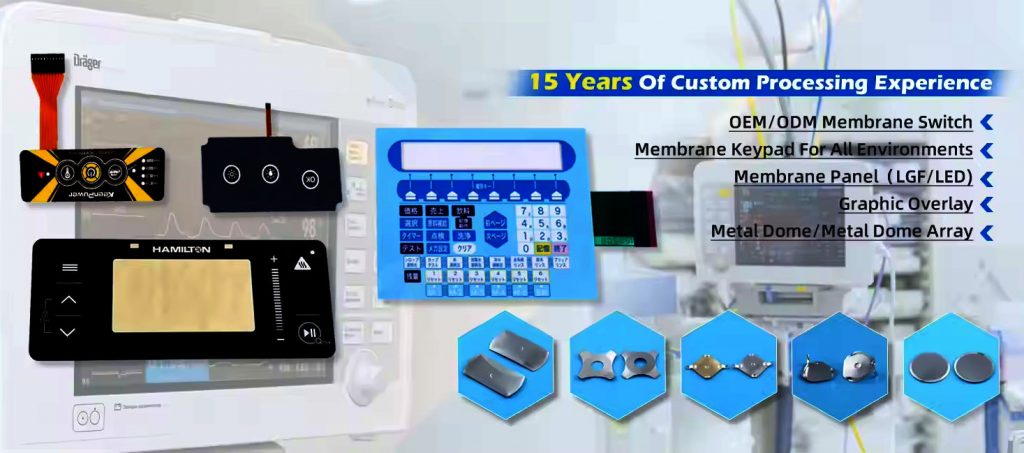A membrane switch panel is an innovative, user-friendly interface that bridges the gap between humans and electronic devices. It is widely used in a variety of industries due to its reliability, versatility, and customizable nature. These panels are essential in sectors like medical devices, industrial controls, consumer electronics, automotive systems, and more, where durability, functionality, and sleek design are paramount.

Key Components of a Membrane Switch Panel
A membrane switch panel typically consists of multiple layers, each serving a distinct purpose to ensure optimal performance:
- Graphic Overlay: The topmost layer of the switch, the graphic overlay, displays the interface’s visual design, such as icons, symbols, text, or branding. This layer is made from durable materials like polyester or polycarbonate, ensuring resistance to wear, chemicals, and UV exposure. Customization options include color matching, embossed buttons for tactile feedback, and even translucent windows for display screens or backlighting.
- Adhesive Layer: The adhesive layer binds the graphic overlay to the circuit layer underneath, maintaining the panel’s structure. It is typically made from pressure-sensitive adhesive materials that ensure a firm bond without adding bulk.
- Circuit Layer: The heart of the membrane switch, the circuit layer, consists of conductive materials such as silver ink or copper, which form the electrical pathways. It can be constructed using either printed conductive inks or flexible printed circuits, depending on the application’s complexity and durability requirements. When the user presses a button on the graphic overlay, the conductive paths are connected, completing the circuit and registering the input.
- Spacer Layer: The spacer layer separates the circuit layer from the switch’s contacts, preventing accidental activations. Only when pressure is applied, the two layers come into contact, ensuring a deliberate and accurate input.
- Back Adhesive: The back adhesive layer secures the membrane switch panel to the underlying substrate, such as a metal or plastic housing. This layer is crucial for mounting the panel securely onto the product it controls.
Advantages of Membrane Switch Panels
Membrane switch panels provide a range of benefits, making them a popular choice for numerous applications:
- Durability: Membrane switch panels are designed to withstand harsh conditions, including exposure to moisture, dust, chemicals, and extreme temperatures. The use of high-quality materials like polyester ensures that these panels remain functional and legible even in challenging environments. This durability makes them ideal for outdoor equipment, industrial machinery, and medical devices.
- Customizability: One of the standout features of membrane switch panels is their high level of customization. Manufacturers can design panels to meet specific requirements, including custom shapes, sizes, colors, and features like backlighting, shielding, and multi-layer construction. Backlighting can be achieved through LED, fiber optic, or electroluminescent (EL) technology, making the switch panel visible in low-light conditions. Additionally, customization extends to the tactile response, allowing for different levels of button feedback based on user preference.
- Low Profile and Lightweight: Unlike traditional mechanical switches, membrane switch panels are thin and lightweight, contributing to sleek, modern designs. This low profile makes them perfect for applications where space is limited or aesthetics are important, such as consumer electronics or automotive dashboards.
- Ease of Cleaning and Sealing: The smooth, sealed surface of membrane switch panels makes them easy to clean and maintain. The sealed design also prevents debris, moisture, and contaminants from affecting the switch’s internal components. This is particularly beneficial in medical, food processing, or industrial environments where hygiene and protection from external elements are critical.
- Tactile Feedback and Enhanced Usability: Membrane switch panels offer excellent tactile feedback, providing a satisfying “click” or response when pressed. This ensures a positive user experience, as operators can easily determine whether their input has been registered. Some switches can be designed with embossed keys or dome-switch technology to further enhance tactile response.
- Cost-Effective: Membrane switch panels offer a cost-effective solution compared to traditional mechanical switches, especially for high-volume production runs. The materials and manufacturing processes involved in creating membrane switches are relatively affordable, providing excellent value for industries looking to balance performance and budget.
- Integration of Additional Features: Modern membrane switch panels can incorporate a variety of additional features, including digital displays, touchscreens, and EMI/RFI shielding for sensitive applications. These enhancements expand the functionality of the switch, allowing it to serve as a more comprehensive control interface.
Applications of Membrane Switch Panels
Thanks to their versatility, membrane switch panels are used in a wide range of industries and applications, including:
- Medical Devices: Membrane switch panels are commonly found in medical equipment due to their hygienic, sealed design, and resistance to harsh disinfectants. Examples include control panels for diagnostic machines, ventilators, and patient monitoring systems.
- Industrial Equipment: In industrial settings, membrane switches are used in rugged environments where durability is crucial. Control panels for heavy machinery, robotics, and factory automation systems benefit from the switch’s resistance to dust, chemicals, and moisture.
- Consumer Electronics: Membrane switches are popular in consumer products like remote controls, appliances, and fitness equipment due to their slim profile and customizable design.
- Automotive Controls: In the automotive industry, membrane switch panels are used for dashboard controls, seat adjustments, and HVAC systems, offering a sleek, integrated look.
Conclusion
Membrane switch panels are a durable, customizable, and cost-effective solution for a wide range of applications. Their low profile, resilience to harsh environments, and high level of customization make them an excellent choice for industries looking for reliable and versatile user interface solutions. Whether in medical devices, industrial machinery, or consumer electronics, membrane switch panels deliver a user-friendly, long-lasting interface that meets diverse operational needs.
